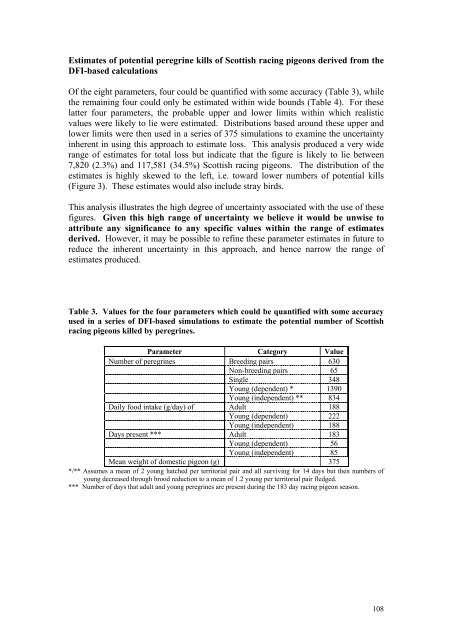RACING PIGEONS â IMPACT OF RAPTOR PREDATION
RACING PIGEONS â IMPACT OF RAPTOR PREDATION
RACING PIGEONS â IMPACT OF RAPTOR PREDATION
You also want an ePaper? Increase the reach of your titles
YUMPU automatically turns print PDFs into web optimized ePapers that Google loves.
Estimates of potential peregrine kills of Scottish racing pigeons derived from the<br />
DFI-based calculations<br />
Of the eight parameters, four could be quantified with some accuracy (Table 3), while<br />
the remaining four could only be estimated within wide bounds (Table 4). For these<br />
latter four parameters, the probable upper and lower limits within which realistic<br />
values were likely to lie were estimated. Distributions based around these upper and<br />
lower limits were then used in a series of 375 simulations to examine the uncertainty<br />
inherent in using this approach to estimate loss. This analysis produced a very wide<br />
range of estimates for total loss but indicate that the figure is likely to lie between<br />
7,820 (2.3%) and 117,581 (34.5%) Scottish racing pigeons. The distribution of the<br />
estimates is highly skewed to the left, i.e. toward lower numbers of potential kills<br />
(Figure 3). These estimates would also include stray birds.<br />
This analysis illustrates the high degree of uncertainty associated with the use of these<br />
figures. Given this high range of uncertainty we believe it would be unwise to<br />
attribute any significance to any specific values within the range of estimates<br />
derived. However, it may be possible to refine these parameter estimates in future to<br />
reduce the inherent uncertainty in this approach, and hence narrow the range of<br />
estimates produced.<br />
Table 3. Values for the four parameters which could be quantified with some accuracy<br />
used in a series of DFI-based simulations to estimate the potential number of Scottish<br />
racing pigeons killed by peregrines.<br />
Parameter Category Value<br />
Number of peregrines Breeding pairs 630<br />
Non-breeding pairs 65<br />
Single 348<br />
Young (dependent) * 1390<br />
Young (independent) ** 834<br />
Daily food intake (g/day) of Adult 188<br />
Young (dependent) 222<br />
Young (independent) 188<br />
Days present *** Adult 183<br />
Young (dependent) 56<br />
Young (independent) 85<br />
Mean weight of domestic pigeon (g) 375<br />
*/** Assumes a mean of 2 young hatched per territorial pair and all surviving for 14 days but then numbers of<br />
young decreased through brood reduction to a mean of 1.2 young per territorial pair fledged.<br />
*** Number of days that adult and young peregrines are present during the 183 day racing pigeon season.<br />
108
















